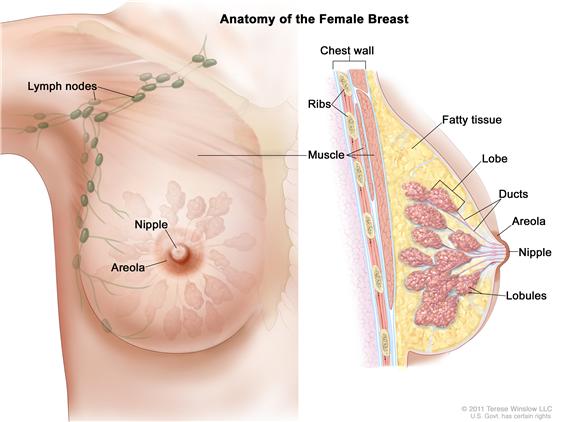General Information About Breast Cancer
Key Points for This Section
Breast cancer is a disease in which malignant (cancer) cells form in the tissues of the breast.
The breast is made up of lobes and ducts. Each breast has 15 to 20 sections called lobes, which have many smaller sections called lobules. Lobules end in dozens of tiny bulbs that can produce milk. The lobes, lobules, and bulbs are linked by thin tubes called ducts.

Each breast also contains blood vessels and lymph vessels. The lymph vessels carry an almost colorless fluid called lymph. Lymph vessels lead to organs called lymph nodes. Lymph nodes are small bean-shaped structures that are found throughout the body. They filter substances in lymph and help fight infection and disease. Clusters of lymph nodes are found near the breast in the axilla (under the arm), above the collarbone, and in the chest.
See the following PDQ summaries for more information about breast cancer:
Breast cancer is the second leading cause of death from cancer in American women.
Women in the United States get breast cancer more than any other type of cancer except for skin cancer. Breast cancer is second only to lung cancer as a cause of cancer death in women. Breast cancer occurs in men also, but the number of cases is small.
Age and health history can affect the risk of developing breast cancer.
Anything that increases your chance of getting a disease is called a risk factor. Having a risk factor does not mean that you will get cancer; not having risk factors doesn't mean that you will not get cancer. People who think they may be at risk should discuss this with their doctor. Risk factors for breast cancer include:
- Older age.
- Early age at menarche (menstruation).
- Older age at first birth or never having given birth.
- A personal history of breast cancer or benign (noncancer) breast disease.
- A mother or sister with breast cancer.
- Treatment with radiation therapy to the breast/chest.
- Breast tissue that is dense on a mammogram.
- Taking hormones such as estrogen and progesterone.
- Obesity.
- Drinking alcoholic beverages.
- Being white.
NCI's Breast Cancer Risk Assessment Tool uses a woman's risk factors to estimate her risk for breast cancer during the next five years and up to age 90. This online tool is meant to be used by a health care provider. For more information on breast cancer risk, call 1-800-4-CANCER.


 Back to Top
Back to Top